
Knowing how to write a procedure is a key skill for anyone looking to build a successful business. Procedures are vital to consistent success for many of the same reasons that processes are important – they let you reliably repeat your successes, isolate and correct your mistakes, and create a business model that lets you scale your operations.
If you don’t know how to write a procedure then you’re dead in the water. Get it right, and the resulting efficiency boosts can put you on track to eclipse your competitors.
This Process Street post will cover the following topics to help you write effective procedures:
- What is a procedure?
- Why are procedures important?
- Preparing to write your procedures
- How to write an effective procedure
- How to write an effective procedure
Read on to learn the 13 steps to writing your business’ procedures effectively, in a way that they will actually be followed instead of getting read once and then forgotten.
What is a procedure?
The idea of what a procedure is, changes depending on who you ask. To many, a procedure is a set of detailed instructions that tell the reader how to complete a task. Others consider policies and procedures to be interchangeable terms, meaning a list of tasks to complete a goal, whether those are detailed, simple, in a basic list, or set out as a flowchart.
For the sake of simplicity, I’ll side with the majority and say that a “procedure” is a list of detailed instructions for completing a given objective.
A standard operating procedure (SOP) is a prefect example of a procedure; a SOP offers detailed instructions on how to perform a routine business activity.
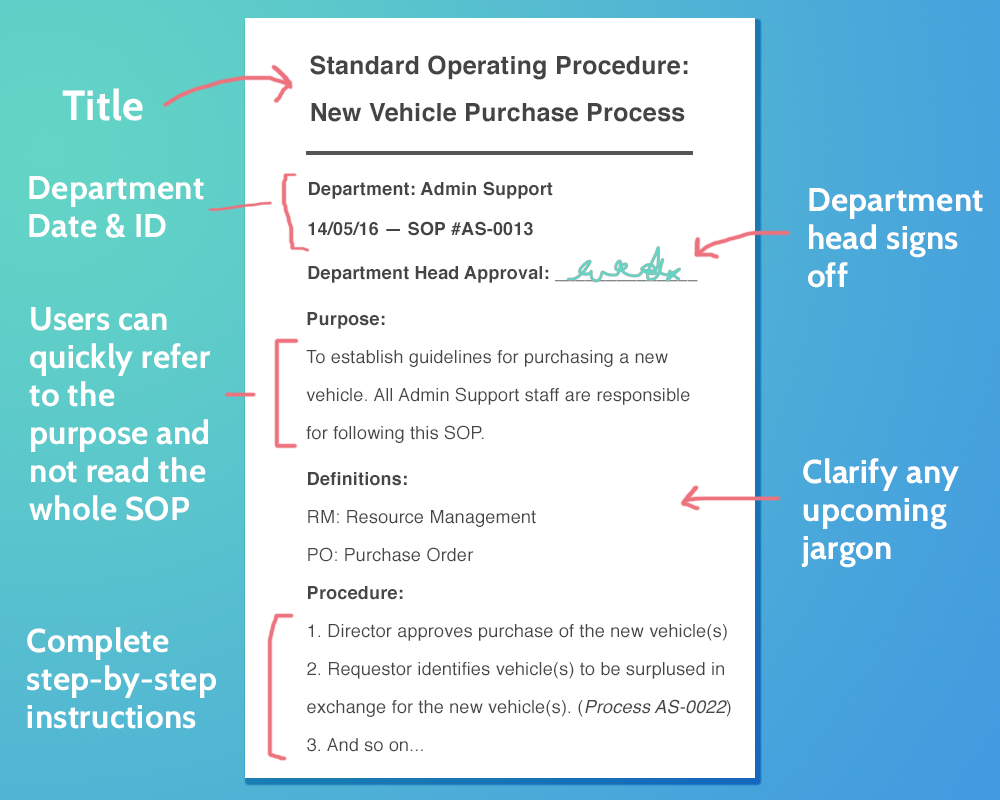
Check out this Standard Operating Procedure Template that the team at Process Street created to make building, implementing, and following SOPs easier.
To get this Standard Operating Procedure Template, log into your account and add it to your dashboard. If you’re not yet a Process Street user, sign up for a free trial.
Anyway, let’s get back to establishing what a procedure is.
So, as we’ve established, procedures are basically a list of tasks or steps that need to be worked through to achieve a particular goal or objective. However, it’s not to say that procedures can’t also be called “processes” though.
Policies overlap with processes, and processes can be extremely similar to procedures. Hell, if you have a good piece of process documentation software then they can often be combined, with a basic task list to show the overall workflow and detailed instructions to supplement each task.
So, again, let’s make it easy to follow.
A procedure is a list of detailed instructions to achieve any given objective. These instructions remain consistent from one project that uses them to the next, but they can be tweaked and improved if the procedure itself is behind under-performance.
Why are procedures important?
Procedures are important for many of the same reasons as processes – with procedure compliance, you consistently carry out tasks, limit human error, and make it easy for newer team members to complete their work to the same accuracy (if not standard) as veterans.
To write a top procedure you need to scrutinize it before you present it. Check out this episode of our podcast Tech Out Loud to learn how Noah Kagan went about growing his 8 figure business:
Tech Out Loud is the only podcast that brings you the most impactful blog posts from the biggest names in tech, straight to your ears.
You can also listen to this podcast on other platforms. Click to see the full list! If you enjoyed this podcast, subscribe for a new episode each week.
The Toyota example
Take Toyota, for example. Between 1948 and the mid-1960s, they introduced incremental changes to their business model, first focusing on physical productivity and then extending that to their manufacturing. The result can be seen in them dwarfing their Western competitors in the following years.
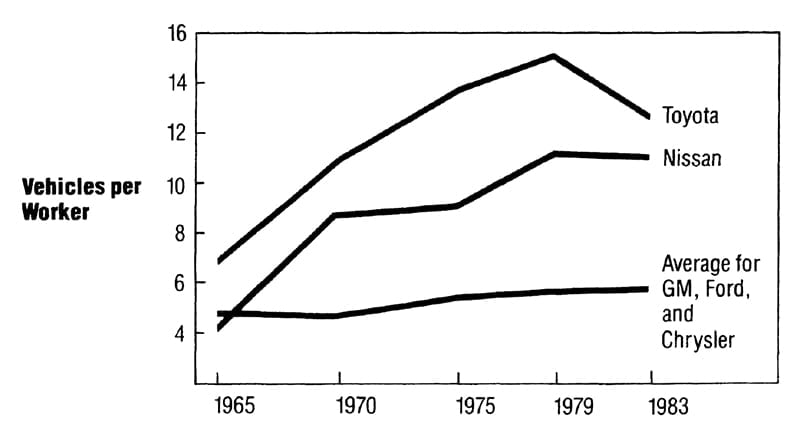
Toyota was able to produce three times more cars on average than its Western counterparts, and it was all down to a systematic improvement of its processes and procedures. In other words, this massive success wouldn’t have been possible without documented procedures to improve.
In fact, without procedures to consistently execute a task through a set list of items, any kind of large-scale success wouldn’t be possible in the first place. In order to scale you need to be consistently successful, and have a persistent level of quality to your products, be that cars or software.
Without procedures, you’re relying on the memory (and motivation) of everyone involved to get things done right. Sooner or later disaster will strike.
Documented procedures also let you improve your business model incrementally through systems like Lean, Six Sigma, and Visual Process Innovation, and easily identify what the cause of any given problem might be. If a particular procedure is producing problems, then you know what to improve. Without them, you might never be able to pinpoint your mistake and are therefore bound to repeat it.
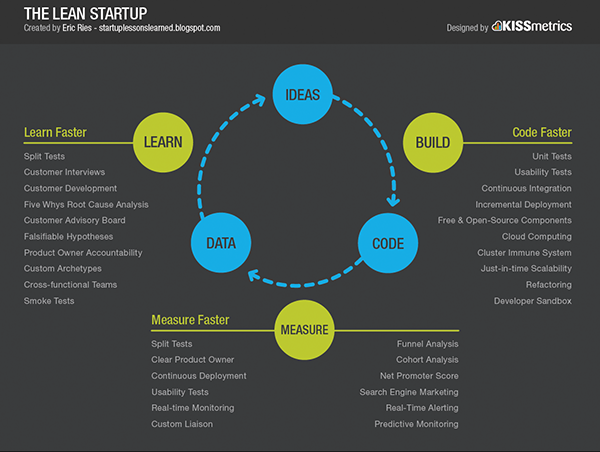
Preparing to write your procedures
When writing your procedures you can’t just dive straight in and record the first thing that comes to mind. Doing so won’t help you, nor anyone else involved in the process – there’s no reason for anyone to see the importance in it, and so it will be ignored.
Instead, you need to start by preparing for your procedure. This is done by:
- Deciding on a platform
- Setting a consistent layout
- Choosing the procedure to document
Remember that you’re not writing your procedure, but instead laying the foundation for its success. It may seem like a lot of work before we’ve even put pen to paper, but the platform and layout you use need only be set once – if you document more than one procedure (which you should) then you can skip straight to choosing which procedure you’re setting up.
Decide on a platform
The platform you store your procedures in will dictate everything from the layout you use to the detail you can go into. It will even affect how long you can use them for before they become redundant and how difficult they will be to update, so don’t make this choice lightly.
You have a few options to choose from:
- Pen and paper
- General document software (Office 365, etc)
- Process documentation software (Process Street, etc)

The choice between pen and paper and going digital with your procedures is a simple one; if you have any desire to grow your business or to reliably replicate your success, you need to go digital.
The physical limitation of needing new paper every time you use your procedures, along with the awkwardness of physically filing completed instances away, let alone finding them again or trying to update your procedure means that only the smallest of informal procedures work on paper. Even then, there’s no benefit to it other than the initial convenience of writing it for the first time without a computer.
Process documentation software is the best way to log your procedures by far, but the choice is now which one to use. Many default to Microsoft Word due to its familiarity, but it falls short in many of the same places as pen and paper.
Word isn’t built for processes, and so anything beyond basic text becomes an unwieldy mess of a document. Not to mention that you have the same trouble of cluttering your physical space if you store printed copies, and cluttering your computer if you store digital files.
Software like Process Street is built for your procedures.
Process Street is super-powered checklists.
It’s state-of-the-art business process management (BPM) software that allows you to document all your procedures into templates. You can then run individual checklists from those templates, each time you want to follow a procedure. These actionable checklists, let you work through your tasks and record your progress as you go.
Watch this short introductory about Process Street.
Everything is stored on our servers, meaning that you aren’t forced to clutter up your own digital or physical space. Downloading and printing copies of your procedures is still an option if you prefer that, though.
Processes and procedures are combined into task lists that allow you to quickly overview the process and also give detailed instructions for every task.
These detailed instructions can be supported with images, videos, files, and the following special features that will make your procedures useful and easier to understand:
- Stop tasks
- Dynamic due dates
- Task permissions
- Conditional logic
- Approval tasks
- Embed widget
- Role assignments
Team members can be assigned to processes and/or individual tasks for better delegation and accountability, while the checklist dashboard lets you easily see the progress of every checklist run from a procedure.
What’s even better about Process Street is that it can connect to thousands of apps through Zapier, webhooks, or API integration. This means you can automate big sections of your processes and procedures, to speed things up and keep it lean.
Watch this webinar about automation for more details on how to automate your processes and procedures:
Make sure your layout is consistent
You need to have a consistent layout over your procedures, as this will make them easier to navigate and see at a glance whether the procedure has been updated recently. They could even be given variations on the same layout depending on the team, in order to differentiate between your various procedures at a glance.
It might sound weird, but a consistent style can even play into your company culture, as it can help to form an identity for those that regularly use it.
Although the layout will ultimately depend on the format you’ve chosen for your procedures, you’ll want to at least answer the following questions in a briefing document before continuing:
- Do you need a cover or contents page? (This is better for lengthy procedures, especially if you’re using physical copies)
- Where will you state the required resources and/or knowledge for the procedure?
- Will you list relevant information? (Highly advised for all procedures)
- Where will relevant information be stored? (In a page at the end, throughout in footnotes, etc)
- Will you use images, videos, and other files, or will it be plain text?
- How often will supporting items (images, files, etc) be used?
- Are you including everything required in the process or linking elsewhere?
- Do you have a set color scheme?
- Where will you locate branding elements?
- What tone will you use?
The answer to any of these questions doesn’t hold much sway on its own, but as long as they remain consistent you’ll find it much easier to navigate your procedures later down the line, and have a sense of cohesion to your documents.
For example, take a look at the below internal procedures that we use to onboard new employees and train our customer service team. You’ll see that both have a consistent layout and style.
Employee Onboarding Checklist
Click here to access the Employee Onboarding Checklist!
Customer Service Training Checklist
Click here to access the Customer Service Training Checklist!
Choose your procedure
This step is simple – you need to choose the procedure you’re going to write.
There isn’t much to say here other than to start with the highest priority procedure that hasn’t been written yet. Do this by assessing the importance of your various processes and the immediate impact of documenting each. If you find one which is both important and will give an immediate performance boost for standardizing, that’s the one you should write.
How to write an effective procedure
Now we’re getting into the meat of the topic – learning how to write a procedure. Any of you who’ve read our other posts on documenting processes and recording standard operating procedures will know much of this already, but to summarize you need to:
- Meet with the teams responsible for the procedure
- Start with a short introduction
- Make a list of required resources
- Document the current procedure
- Add supporting media
- Include any relevant resources
- Check the procedure is accurate
- Test in a controlled environment
- Make improvements if necessary
- Deploy
Let’s dive right in.
Meet with the team(s) responsible for the procedure
First up, you need to meet with the team(s) responsible for carrying out the procedure. If possible you should arrange to meet up with everyone at once so that you don’t have to repeat yourself (or at least try to meet with all of the senior members). The idea here is to make sure that you have plenty of opinions on what the procedure is and how to improve it, all while creating a sense of ownership and demonstrating its importance.

These are the people who will carry out the procedure once it’s documented after all – if you win them over this early, you’re all but guaranteed to have them actually stick to it in practice.
At the very least you need to cover the following during the meeting (try chatting a little before diving right in though, as this can help set a collaborative feel):
- Identify the purpose of the procedure (inputs, outputs, and goals)
- Define a set start and end point
- Identify your audience
- Agree on the level of detail required
- Talk through the basic steps and principles
- Check that you know how the procedure should be done, and how it is actually done currently
If multiple teams are required, you can either meet with them all at once to ensure that everyone’s on the same page or meet one by one to go really in-depth. Be sure to take lots of notes or record the meeting so that you can review it later if you miss (or forget) anything.
You also have two options going forwards; you can go off with this information and write the procedure on your own or continue to work with the relevant team(s) to collaboratively record it. I’d recommend the latter if you can line up your schedules to do so, as this will make the team(s) feel like they are co-authoring the procedure, which in turn should help them to promote any changes and make it want to succeed.
If you need a little help choosing the best video conferencing app on the market, check out the table below to see how they measure up.
If working with them isn’t possible due to time or schedule constraints, don’t worry. Instead, just go ahead and work through the following steps yourself, then meet up with the team again once you need to check that the procedure is correct.
Start with a short introduction
We’re finally getting to the writing! As with almost any kind of content, however, you need to start with a bang in your introduction.
Note the audience, what the procedure is designed to do, who will do it, and why it’s important (usually through the context of how fits with the rest of the company). If possible, try to date your procedure too, as this will avoid any potential confusion as to what version of the procedure your team is using.
You don’t have to include and fancy examples to back up your claims or make the procedure interesting, but it will be much better if you can. The more interesting and engaging the procedure is, the more likely your team will stick to it instead of cutting corners.
Make a list of required resources
Next up is the list of resources for the procedure. Think of this as your ingredient list – the resources and knowledge a person will need in order to work through the procedure.
The best way to get this right is to consider both what you would need to complete the procedure, and what knowledge and experience you have that the regular intended audience lacks. Remember to include tools, passwords, keycodes, technology, physical items (pen, paper, etc), and anything else that might be required.
Document the current procedure in a basic task list
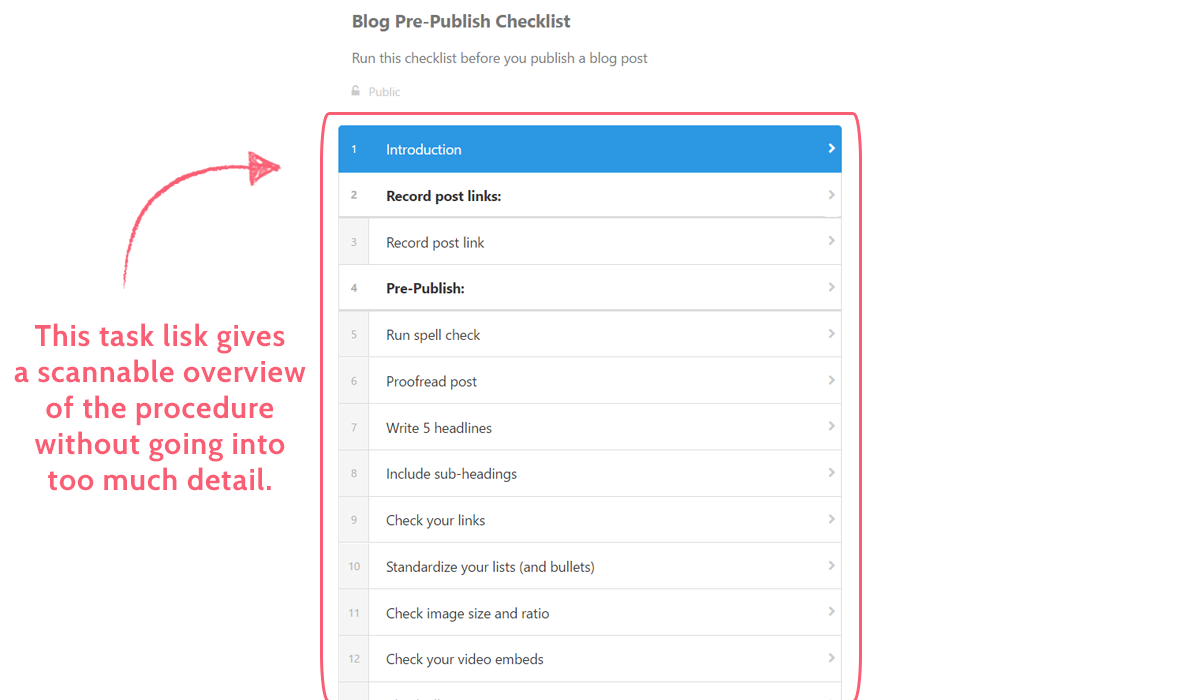
It’s finally time to get to writing your procedure. Using the platform and layout you’ve decided on plus the notes from your meeting with the team who currently performs the process, write out the steps to complete the procedure in a simple task list. Don’t worry about adding images, videos, or supporting files for now – just focus on getting the text and instructions right.
Break the procedure down into a task list where each item is a single, clear instruction. For example, if you’re documenting an editing checklist, instead of “proofread the post” have separate tasks for “check spelling”, “check grammar”, “check that it makes sense”, and so on.
The trick here is not going into so much detail that you bore the reader to death. Make sure that they can understand everything they need to know in order to complete the procedure at a glance, rather than making them work to get the information they need.
For example, we do this by having a task list containing one-sentence summaries of every task, all of which start with an action term, like “write” or “discuss”. Then, when you click on any of these tasks, a description appears telling us how to complete the task while remaining as brief as possible.
Add supporting media
Adding other types of media to your procedure is a great way to more easily explain what needs to be done and keep your reader interested (making them more willing to follow the method closely). Giving your team 20 tasks of block text is all but guaranteed to make them want to cut corners, but by limiting the text to necessary items and using images, videos, and other files to back up your point you’ll get a far greater proportion of them to stick to what you tell them.
It can also be much easier to show what needs to be done in an image or video rather than trying to type out instructions – a 30 second screencast can explain what to do by showing the audience, rather than spending 500+ words and multiple screenshots trying to describe it.
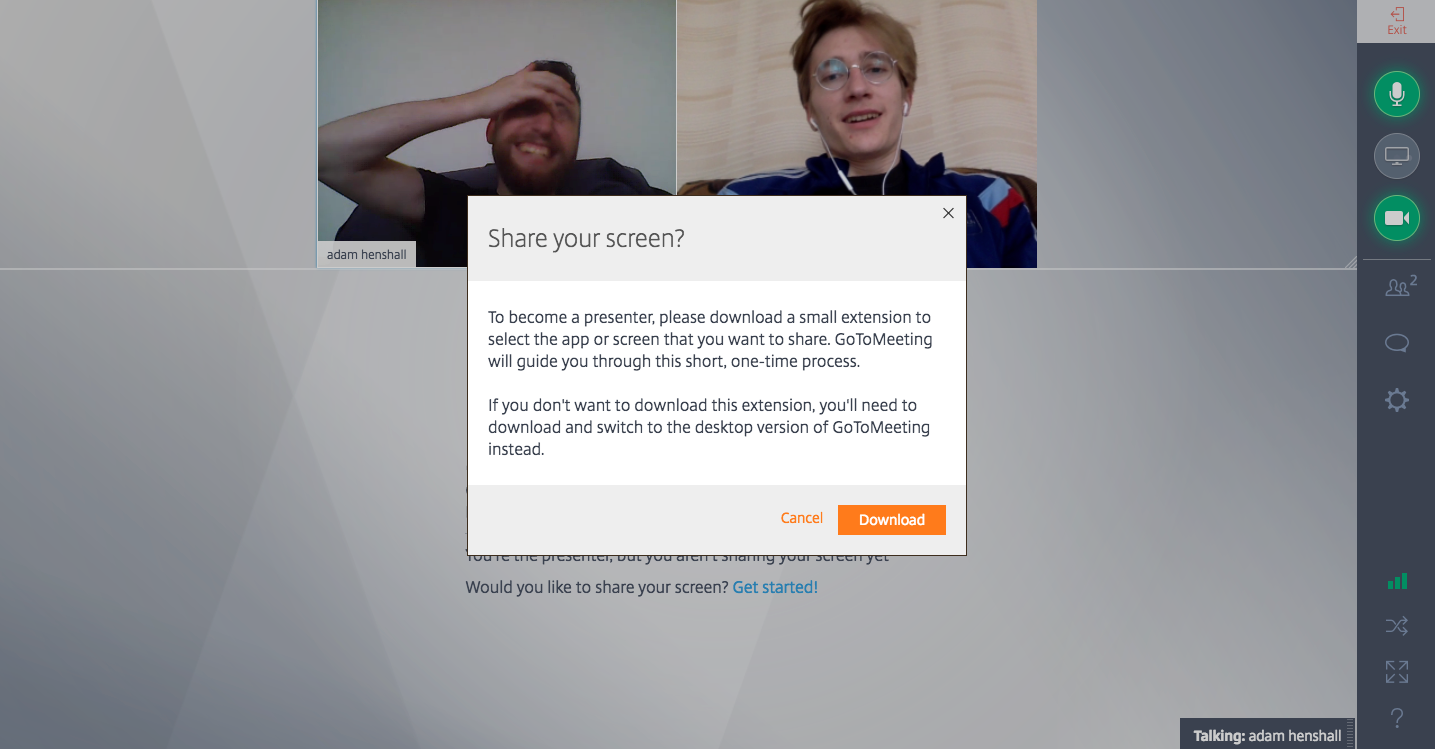
The same goes for supporting documents, such as forms that need to be completed. If you attach them to a task ready to go, you’re far more likely to have people stick to your procedure and complete it fully rather than cutting corners and skipping straight to the next step.
Include any relevant resources
Whether you list further reading for one or more of the topics you’ve covered (ebooks, useful articles, etc) or you note the sources you got your information from, it’s a good idea to include any relevant resources at the end of your procedure. That way any curious party can go further and improve their skills if they want to.
I’d also recommend you include links to your other related procedures so that everyone can easily navigate your company’s infrastructure. That way if someone can’t find the procedure they’re looking for (or forget where it is), they can locate it through any of your other related procedures.
Check that the procedure is accurate
It would be amazing if you could learn how to write a procedure, create it perfectly on your first try, and have everyone use it without fail. Unfortunately, no matter how good the procedure you write is, if you don’t factor in how everyone currently works you’ll never get them to adapt to the new method.
Next, you need to check that the process you have documented is accurate for how it is currently performed – you’ll be able to save some time if you’ve done all of the steps thus far while in meetings with the team who carry it out.
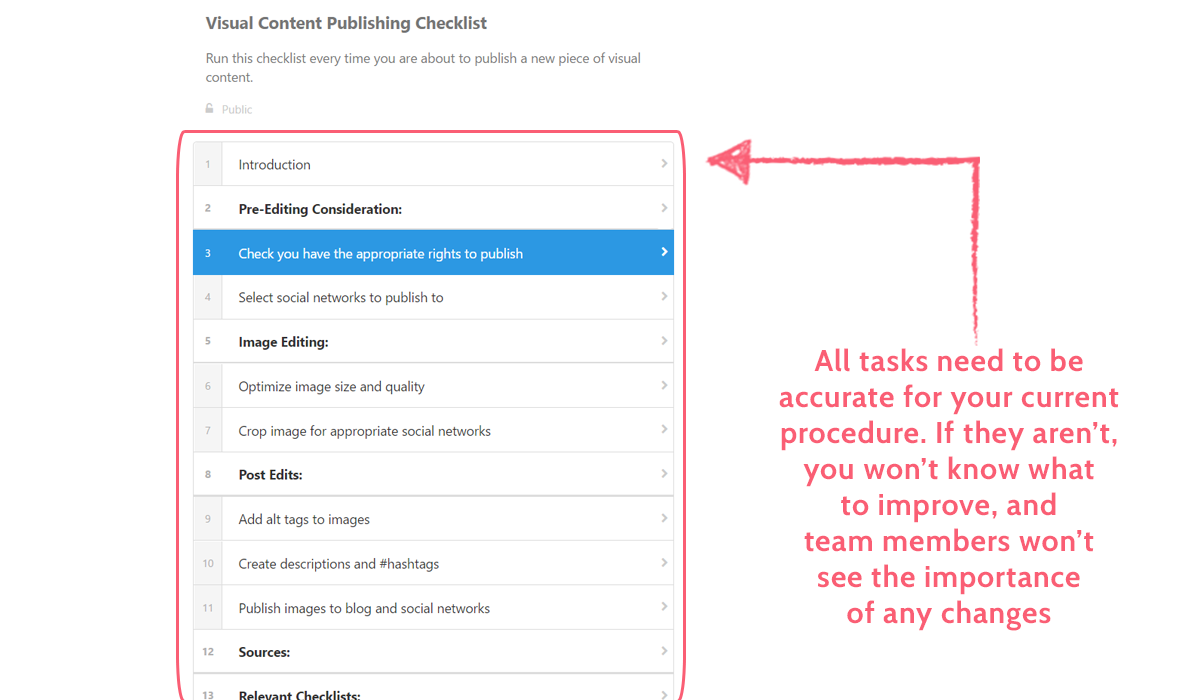
Check with the team that the steps you’ve documented cover the procedure in its current state (not an idealized one – it needs to be accurate, not impressive). Once you’ve done that you can move on to testing the procedure to make doubly sure that no steps have been forgotten.
Test it in a controlled environment
Now it’s time to test your procedure to triple check that nothing has been missed. As a bonus, these tests should also highlight whether the procedure you’re currently using is adequate, or whether the procedure itself needs tweaking (rather than just making sure everyone sticks to it).
Take the inputs, outputs, and goal that you identified when preparing, then measure the performance of your procedure when followed to the letter. Depending on how complex the procedure is you may need a separate success metric beyond whether each task was completed, so consider using a key performance indicator (KPI) common to the process you’re carrying out.
In other words, look beyond whether each task was completed. If you were sending an email with a call to action, check how successful that CTA was. If the procedure was processing an order, check the accuracy of the records produced, how quickly it was completed, and how much time (and manpower) it took to do so.
Make any improvements if required
The results of your tests should have highlighted whether your procedure is good to deploy or if you need to make some improvements. If the latter, you need to draft out those improvements now to make the most of the momentum you have.
This might sound a little daunting, but don’t worry too much – if you thoroughly tested your procedure then you should be able to use the results gathered to tell what needs improving, and where those improvements would be best to make.
If you’re not sure where to start though, use this Process for Optimizing a Process checklist:
Click here to access The Process for Optimizing a Process!
Either way, make sure that you meet with the team who will be carrying out the procedure (again), and together try to come up with improvements you can make to drastically improve your results. Remember that even small increases in performance can make a massive difference over time, so be sure to give it your all.
If you end up making any changes, be sure to re-test the procedure and measure the results anew, then repeat until you’re satisfied with the outcome.
Deploy it
Now all that’s left to do is to deploy the procedure and release it to the teams who will be using it from this point onwards. There’s not much to say for this step, other than this should be much easier if you’ve been closely working with either the team who will be using it or the senior staff at the very least.
If you’ve largely worked on your own up to this point, now is your last chance – you have to meet up with the relevant team. Go through the old procedure, explain why it wasn’t working (using the data from your tests), and get them on board with the improvements you’ve made, along with the method for completing and tracking the newly written procedure.
Without any kind of context, all of your work will go to waste. Everyone involved with this procedure in practice needs to know and agree with why it’s important, and why any changes had to be made.
Practice makes perfect
If you managed to do all of this then congratulations – you’re on your way to the same kind of efficiency spike which Toyota turned into a weapon to eclipse their competition. Now you just need to make sure that everyone sticks to the procedure, and any problems are dealt with as they come.
Other than that, now that you know how to write a procedure, it’s time to move on and document the next most important procedure in your company. Before you know it you’ll have a comprehensive framework for everything you do, making your entire business more consistent, efficient, and above all scaleable.
If you’re keen to find out more about how to write procedures, check out these related articles:
Articles relating to how to write a procedure
- Ultimate SOP Guide: Standard Operating Procedures Made Easy (Free Templates!)
- Simple SOP Format Guide: How to Write Standard Operating Procedures
- Audit Procedures: A Quick Tour with 19 (Free) Templates
- How to Implement Effective Inventory Management Procedures
- Why You Need to Document Your Processes and Procedures (and How to Do It)
- What Are SOPs & How Do You Write Good Ones?
- The Benefits of Standard Procedures with Tony Brown
- The ABC’s of Documenting Standard Operating Procedures — and Why Your Business Can’t Afford Not To
How do you write and store your procedures? Have any questions or reservations about the whole process? I’d love to hear from you in the comments below.






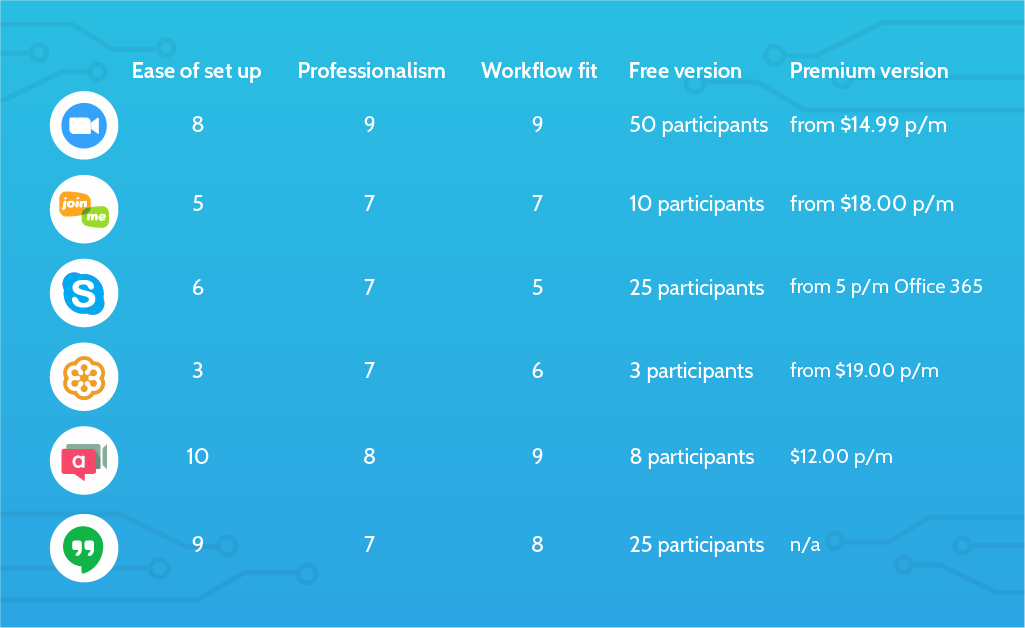

Ben Mulholland
Ben Mulholland is an Editor at Process Street, and winds down with a casual article or two on Mulholland Writing. Find him on Twitter here.